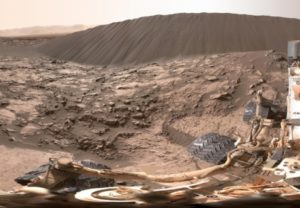Research
Research Overview:
The Geomorphology and Aeolian Landscape Evolution (GALE) lab focuses on the interactions between wind and the surface of Earth and other planets. Wind carries sediment, forming ripples and dunes that can grow and coalesce into whole dune fields. These dune fields sometimes become preserved and form a geologic record of the ancient environment. This occurs on Earth, but dunes and preservation have also been observed on Mars, Titan, Venus, Pluto, and even a comet.
Research goals:
Establish and test sediment transport equations for arbitrary fluid-gravity conditions
Reconstruct the sediment budget on Mars now and in the ancient past
Tie together modern bedform formation and ancient sandstone preservation

Modern aeolian dunes
Dunes on Earth form on all continents and in a wide variety of sized and morphologies. Dunes morphologies reflect the local wind conditions, but as they become larger and larger, dunes take longer to reorient to changes in the climate. Some dunes present on Earth today reflect patterns left over from the last ice age, or even further into the past. From massive dunes, many 100’s of meters high, to small wind ripples only a single centimeter high, aeolian bedforms give information about the wind and atmosphere at a wide range of scales. We study dunes to study how the Earth couples with the atmosphere. Many questions about these massive piles of sediment remain including:
How does the spacing of dunes relate to their age?
What does the steepness of a dune slope say about its material properties?
How are bedforms related to waveforms?

Ancient aeolian dunes
In the Jurassic (~200 million years ago), North America housed a sand dune desert that rivaled the Sahara today. The central southwestern United States, including Arches National Park, Canyonlands National Park, and Gran Canyon National Park, preserve evidence of this ancient desert with thick successions of aeolian sandstone. Jurassic aeolian units studied by this group include the Navajo, Page, and Entrada Sandstones. In the Gulf of Mexico, the Norphlet sandstone, another Jurassic aeoilan formation, holds natural resources of particular human interest. We study surface exposures of Jurassic sandstones to understand how a dune field can become preserved in the rock record, and how that rock record can be a revervoir for resources today. Some questions being addressed by our group include:
How do different types of aeolian stratification respond to diagenesis?
How do interdune-bounding surfaces vary in scour-driven dry aeolian systems?
How much time is missing from the aeolian rock record?
 Wind on other planets
Wind on other planets
Wind and sediment transport by wind can occur on any body with an atmosphere. Dunes and related bedforms have been seen on 7 different bodies in our solar system, and new missions may reveal new locations where dunes are hiding. Mars, in particular, is a great natural laboratory for studying aeolian transport because wind is the dominant mechanism of surface change. We study sediment transport on Mars using images from orbiters and rovers. The surface of Mars is complex and diverse, and we use geological indicators of surface-wind interactions to remotely interpret the environment today and in the ancient past. Some questions being addressed by our group include:
How are transverse aeolian ridges formed on Mars?
How much sand is generated on Mars from modern impacts? Ancient impacts?
How much erosion has wind caused on Mars?

